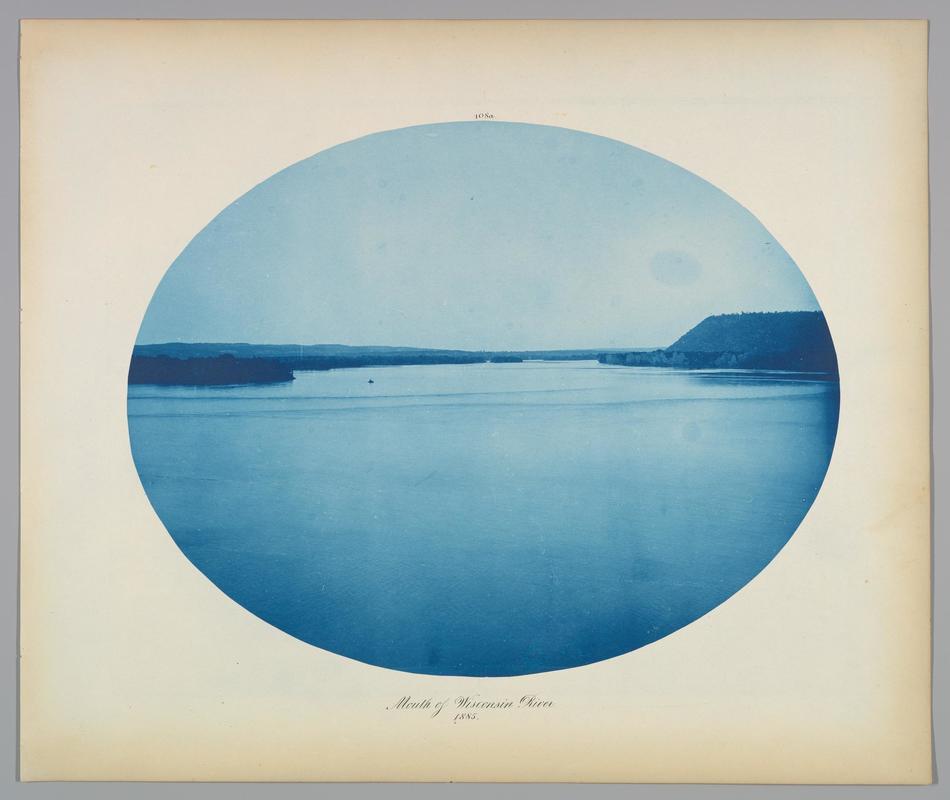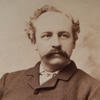More about Mouth of Wisconsin River

Sr. Contributor
Henry Peter Bosse may not have thought of his cyanotype photographs of the Upper Mississippi River as works of art, but he did have a sense of aesthetics and presentation when he produced them in their final format.
Bosse worked for the U.S. Army Corp of Engineers as a draftsman for about 30 years, beginning in 1874; his main job was documenting improvement projects on the Mississippi River, mainly between Minneapolis and St. Louis. These projects had the goal of making the river more navigable by creating deeper channels and improving levees, harbors, and banks.
Bosse documented the river by making maps and drawings, and more importantly for us, taking photographs. He didn’t use just any photographic methods, though; his preferred method used an uncoated paper process known as the cyanotype, which produces a gorgeous, blue-tinted image when processed and printed. He likely did not choose this method for aesthetic reasons, but for more practical ones: low costs and ease of processing, as there was no darkroom needed. The printed images were also known as blueprints, and were widely used for architectural plans, engineering drawings, ship-building, and other uses. The “blueprint” itself has been rendered obsolete for this purpose, but the term is still used today to refer to design drawings or renderings.
Cyanotypes, introduced by Sir John Herschel in 1842 and already employed for scientific and artistic purposes by Anna Atkins, use plain, uncoated paper, as opposed to paper (or other material) that is coated with a light-sensitive emulsion. These emulsions can be very different from one another and are made up of different light-sensitive chemicals, but the most common emulsions are collodion, albumen, gelatin, and silver salts. In a cyanotype, the paper is coated with a light-sensitive solution that soaks into the paper itself; when the paper is dry, it is exposed to light under a negative, then washed in water. The chemical reactions cause the image to turn blue (cyan) while the white paper shows through, and voila, you’ve got a cyanotype!
Bosse used a large-format 11” x 14” camera and, even though these photos were part of a government project of documentation, Bosse composed them as though he were taking them for his own pleasure or for sale. A historian with the National Park Service said, "He set things up like a painting and captured the first major transformation from the natural to the commercial river, with railroad and wagon bridges and the growing frontier villages." Sometimes Bosse kept the lens open for a long time in order to catch the light at its best, and the movement of the river or vegetation would be blurred, but this only adds to the artistic look of the final image.
Bosse’s photograph Mouth of Wisconsin River was/is part of an album of cyanotypes that was put together and presented to his superior, Major Alexander Mackenzie, the Corps Chief of Engineers; the album was found by an antique dealer (in Mackenzie’s former home) and sold at a Sotheby’s auction in 1990. Several of these albums were made and given to various people in the Corps; they were bound in leather with hand-lettered titles and descriptions, and often a date as well. The photos were usually either cut in an oval shape or printed so that they appeared to have an oval-shaped mat surrounding them. It's unknown how many of these albums still exist; a couple of them have been located on Corps of Engineers ships, where they had been lying around for many years.
Sources
- Anfinson, J. O. (1996). Henry Bosse's views of the Upper Mississippi River. US Army Corps of Engineers, St. Paul District.
- Arland-Fye, B. (2001, November 24). River treasures: Quad-citian who chronicled the Mississippi river gains fame almost a century after his death. The Quad-City Times. https://qctimes.com/news/river-treasures-quad-citian-who-chronicled-the…
- Brown, C. (2011, December 27). Locked in St. Paul vault: $4.5 million Photo album. Star Tribune. https://www.startribune.com/locked-in-st-paul-vault-4-5-million-photo-a…
- Inductees. National Rivers Hall of Fame Inductees. (n.d.). https://www.rivermuseum.com/national-rivers-hall-of-fame-inductees/indu…
- mohsen497, A. (2016, October 25). Cyanotypes of Henry Bosse. 4.341 INTRO TO PHOTOGRAPHY AND RELATED MEDIA. https://mitphoto2016.wordpress.com/2016/10/25/cyanotypes-of-henry-bosse/
- Ritzenthaler, M. L., & Vogt-O'Connor, D. (2010). Photographs: Archival care and management. Society of American Archivists.
- Roba, W. (1992). Draughtsman, Photographer, Artist. Who was the Mysterious Henry Bosse? Ramsey County History, 27(4).












I'm considering a cross country road trip and am going to try and match this picture with the real mouth of the Wisconsin River!